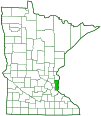reticulated pirate spider
(Mimetus notius)
Conservation • Description • Habitat • Biology • Distribution • Taxonomy
Conservation Status |
|
|||||||
| IUCN Red List | not listed |
|||||||
| NatureServe | NNR - Unranked |
|||||||
| Minnesota | not listed |
|||||||
Description |
||
Reticulated pirate spider is a small to medium-sized, eight-eyed spider. It occurs across North America. Females are ⅛″ to 3 ⁄16″ (4.2 to 5 mm) long. Males are slightly smaller, ⅛″ (3.5 mm) long. The covering (carapace) of the front part of the body (cephalothorax) is longer than wide, has a low profile when viewed from the side, and is armed with long curved spines. It is pale yellow with black markings, including four black lines. The lines are wide, irregular, and have branches connecting them. They extend backward from the eyes and converge on a groove in the thorax. There are eight eyes in two rows. The last part (cymbium) of the finger-like mouthpart (palp) has a spine at the tip but no other spines near the tip. The palp on the female has a claw. The abdomen is high in front and yellow but mostly covered with black markings. It is armed with long straight spines. The legs are very long and slender. The first pair is 1½ to 1⅓ times as long as the fourth pair. They are pale with black spots and bands, and are armed with long spines. The third segment (femur) is not dark near the tip. It has numerous black spots on the underside but does not have two distinct black lines. The fifth segment (tibia) and sixth segment (metatarsus) each have a rows of long, slightly curved spines with a row of much shorter spines between them. |
||
Size |
||
Female Body Length: ⅛″ to 3 ⁄16″ Male Body Length: ⅛″ (3.5 mm) |
||
Web |
||
|
||
Similar Species |
||
Habitat |
||
Dry places; bushes, fences, and occasionally houses |
||
Biology |
||
Season |
||
April to July |
||
Behavior |
||
|
||
Life Cycle |
||
|
||
Food |
||
|
||
Distribution |
||||
|
Sources |
|||
Occurrence |
||||
Not known to occur in Minnesota. |
||||
Taxonomy |
|||
| Class | Arachnida (arachnids) | ||
Order |
Araneae (spiders) | ||
Suborder |
Araneomorphae (typical spiders) | ||
| Infraorder | Entelegynae | ||
Superfamily |
Mimetoidea (pirate spiders) | ||
Family |
Mimetidae (pirate spiders) | ||
Genus |
Mimetus (canibal spiders) | ||
Synonyms |
|||
|
|||
Common Names |
|||
reticulated pirate spider |
|||
Glossary
Carapace
The hard, upper (dorsal), shell-like covering (exoskeleton) of the body or at least the thorax of many arthropods and of turtles and tortoises. On crustaceans, it covers the cephalothorax. On spiders, the top of the cephalothorax made from a series of fused sclerites.
Cephalothorax
The front part of a spider’s body, composed of the head region and the thoracic area fused together. Eyes, legs, and antennae are attached to this part.
Femur
On insects and arachnids, the third, largest, most robust segment of the leg, coming immediately before the tibia. On humans, the thigh bone.
Palp
Short for pedipalp. A segmented, finger-like process of an arthropod; one is attached to each maxilla and two are attached to the labium. They function as sense organs in spiders and insects, and as weapons in scorpions. Plural: palpi or palps.
Visitor Photos |
|||||
Share your photo of this arachnid. |
|||||
| This button not working for you? Simply email us at info@MinnesotaSeasons.com. Attach one or more photos and, if you like, a caption. |
|||||
Alfredo Colon |
|||||
 |
|||||
MinnesotaSeasons.com Photos |
|||||
|
|||||

Slideshows |
||

Visitor Videos |
|||
Share your video of this insect. |
|||
| This button not working for you? Simply email us at info@MinnesotaSeasons.com. Attach a video, a YouTube link, or a cloud storage link. |
|||
Other Videos |
|||

Created: 4/22/2019
Last Updated:


